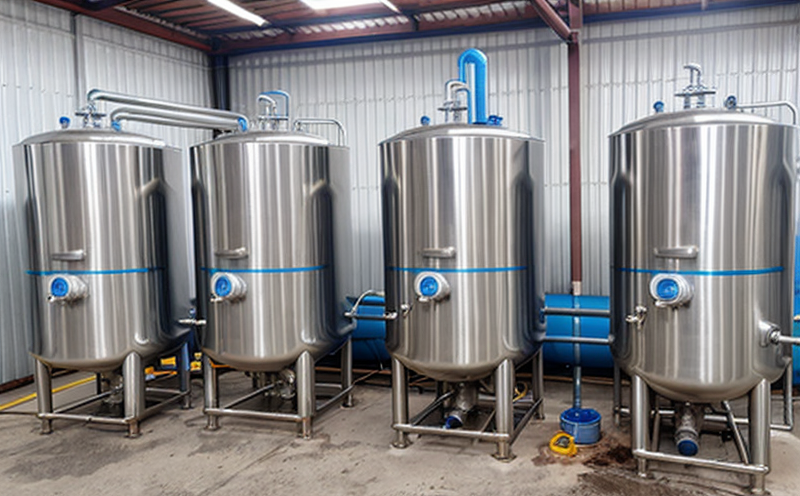ISO 11869 Trace Elements Test in Cooling Water
The ISO 11869 standard provides a method for determining trace elements in cooling water systems. This testing is critical to ensure the quality and efficiency of industrial processes that rely on these systems, including power generation, manufacturing, and chemical production.
Trace elements play a vital role in the performance and longevity of cooling water systems. Elements such as copper, zinc, iron, nickel, and chromium can influence the corrosion rates, microbial growth, and overall stability of the system. The ISO 11869 method allows for accurate quantification of these trace elements to maintain optimal conditions within the cooling circuits.
The testing process involves several steps, starting with the collection of a representative sample from the cooling water circuit. This sample is then prepared according to ISO guidelines to ensure accuracy and precision. The analytical techniques used include inductively coupled plasma optical emission spectrometry (ICP-OES) or atomic absorption spectroscopy (AAS), both widely recognized for their sensitivity and reliability.
Once the samples are analyzed, a comprehensive report is generated detailing the concentration levels of each trace element detected. This information is crucial for identifying any potential issues with the cooling water system that could lead to equipment degradation or operational inefficiencies. The results can also be used as part of a broader strategy to minimize environmental impact by optimizing water usage and reducing chemical additives.
The importance of this test cannot be overstated, especially in sectors where high purity standards are required. For instance, in the power generation industry, trace elements can affect boiler efficiency and heat transfer rates. In pharmaceutical manufacturing, ensuring low levels of contaminants is paramount for product safety and regulatory compliance.
Regular monitoring using ISO 11869 ensures that cooling water systems operate at peak performance while minimizing operational costs associated with maintenance and downtime. By adhering to this standard, facilities demonstrate their commitment to maintaining sustainable practices and meeting international quality standards.
The process outlined in ISO 11869 is not only beneficial for current operations but also serves as a benchmark for future improvements. It encourages ongoing evaluation of best practices and promotes continuous enhancement of water management strategies across various industries.
International Acceptance and Recognition
The ISO 11869 standard has gained widespread acceptance worldwide due to its robust methodology and consistent results across different laboratories. This international recognition enhances the credibility of test reports produced by adhering facilities, making it easier for them to comply with global regulations.
- Compliance with ISO 11869 ensures that testing results are universally accepted by regulatory bodies and industry stakeholders.
- The standard's detailed procedures minimize discrepancies between laboratories conducting similar tests, leading to more reliable data across borders.
- Affiliation with reputable organizations such as ASTM or EN further strengthens the global standing of facilities performing ISO 11869 tests.
By aligning their testing practices with internationally accepted standards like ISO 11869, companies position themselves favorably in terms of reputation and market competitiveness. This alignment also facilitates smoother interactions with international partners and clients who demand stringent quality controls.
The adoption of this standard reflects a commitment to excellence and reliability, which are essential attributes for any business operating within the competitive global market.
Environmental and Sustainability Contributions
The ISO 11869 trace elements test plays an integral role in environmental sustainability efforts by helping organizations identify and mitigate potential risks associated with their water usage. By monitoring trace element concentrations, facilities can take proactive measures to prevent contamination of local ecosystems.
One significant benefit of adhering to this standard is the ability to reduce chemical input into cooling systems through optimized treatment processes. Lower levels of additives such as corrosion inhibitors or biocides directly translate to decreased environmental impact and reduced operational costs for businesses.
Furthermore, regular testing allows companies to track changes over time, enabling adjustments based on new data points. This continuous improvement approach fosters a culture of responsibility towards the environment, aligning with broader sustainability goals.
Facilities that prioritize ISO 11869 compliance also contribute positively to public health by ensuring safe water supplies used in industrial processes. The accurate identification and management of trace elements help protect human health from harmful exposures while supporting overall wellness initiatives.
In summary, the implementation of ISO 11869 contributes significantly to environmental stewardship by promoting efficient resource utilization, reducing waste generation, and enhancing community well-being.





